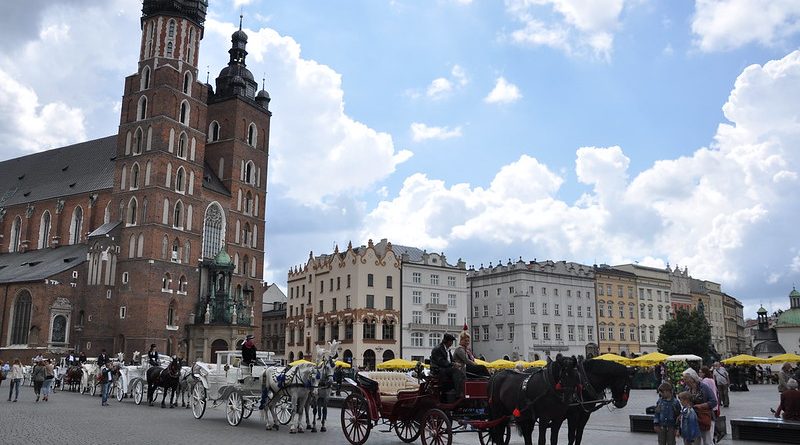Top Ten Places to visit in Poland
One of Europe’s most significant emerging powers, Poland has an extensive and rich history stretching back over a thousand years. After a 20th century ridden with war and political oppression, Poland has reemerged as a bastion of progressive, liberal ideals, with free education and healthcare for its citizens. It boasts one of Europe’s most distinct cultural and historical identities.
Warsaw
Poland’s capital city Warsaw often flies under the radar as a tourism destination but it has cemented its growing reputation as one of Europe’s greatest cities. An increasingly important global financial centre, Warsaw is also a city, which reflects Poland’s multi-faceted history. The historic Old Town epitomises this better than anywhere else, featuring a wealth of Gothic, Renaissance and Romanesque buildings. It is also one of Europe’s leading cultural centres, with major museums such as the National Museum and the Zacheta National Gallery of Art ranking amongst the finest on the continent.
Krakow
Easily amongst the most beautiful cities in Europe, Krakow is often considered to be Poland’s cultural capital. Known for its architectural and artistic pedigree, Krakow is home to many stunning feats of architecture. Major sights include the Krakow Ghetto, where the city’s Jewish population were cruelly housed in the pre-war years prior to the implementation of concentration camps. The Wawel Cathedral and the Wawel Castle are amongst the city’s finest pieces of architecture.
Auschwitz
Poland’s most-visited tourism site is amongst the most sombre yet essential experiences one can have. The Auschwitz Concentration and Extermination Camp was the most notorious of its kind during the Second World War. Established in 1940 as a means to house Polish political prisoners, its function grew increasingly disturbing as the Nazis implemented the ‘Final Solution’ and began to exterminate Jews and other minorities en masse. It is estimated that over 1.1 million people were executed within the confines of Auschwitz. It was liberated on 27 January 1945 and since its closure the site has been preserved as a historic landmark, an essential reminder of man’s inhumanity to man in one of the darkest chapters in human history.
Wieliczka Salt Mine
On the outskirts of Krakow in the small town of Wieliczka is one of Poland’s most unique and interesting attractions-the Wieliczka Salt Mine. Having only closed in 2007, this mine was consistently active since the 13th Century as a major producer of table salt. Deep underground is a quirky subterranean museum, which is home to four chapels all carved out of rock salt. A bizarre yet engaging destination.
Chapel of Skulls
In a small town in the Lowe Silesia region of Poland is the Skull Chapel, one of the country’s more morbid tourism sites. The Skull Chapel, as its name indicates, is a mass grave dating back to the late 18th Century. Its interior is almost entirely covered with skeletal remains, giving it a unique and macabre character. It is one of the only monuments of its kind in the world and worth seeking out for its sheer strangeness.
The Crooked Forest
Another of Poland’s more off-beat destinations is the Crooked Forest, a grove of pine trees in the West Pomerania region of the country. The pine trees date back to around 1930 and are known for their strange and unconventional shape. While it is believed the trees get their distinct shape through human intervention, the means are unknown.
Great Masurian Lakes
One of Poland’s most naturally stunning destinations, the Great Masurian Lakes are located in the country’s northeastern region. Comprised of over 2000 lakes connected by a network of canals and rivers, the Great Masurian Lakes are one pf the country’s major tourism hubs due to their spectacular natural beauty and available watersports activities.
Gdansk
The country’s most significant port city, Gdansk is located along the Baltic coast and is a major trading epicentre fore the country. It is a major site in Poland’s political history, having previously been a point of contention between Nazi Germany and Poland prior to the Second World War and served as the birthplace of the Solidarity Movement against Communist rule. The modern-day city is best-known for its picturesque beauty, stunning, multi-faceted architecture and top-tier museums, the most notable of which being the Museum of the Second World War.
Bialowieza Forest
One of Poland’s most beautiful places, the Bialowieza Forest is an expansive primeval forest, once part of a much larger region which stretched across the entirety of the European plain. One of the most unique natural regions on the continent, it is one of the last environments inhabited by bison in Europe. A major destination for hikers and cyclists, it is one of the most spectacular places in the entire country.
Tatra Mountains
Straddling the border between Poland and Slovakia is the Tatra Mountain range, one of the most beautiful and scenic parts of either country. On the Poland side of the border, the mountains fall under the domain of the Tatra National Park. Ideal for hikers and nature enthusiasts, the mountains provide jaw-dropping scenery one wouldn’t expect when visiting this part of the world.
Destination – Poland




